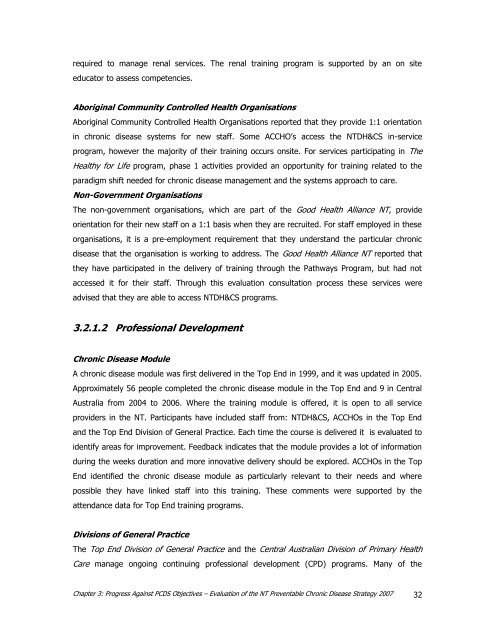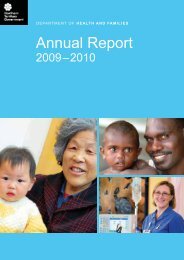PCD Strategy Evaluation 2007.pdf - NT Health Digital Library ...
PCD Strategy Evaluation 2007.pdf - NT Health Digital Library ...
PCD Strategy Evaluation 2007.pdf - NT Health Digital Library ...
Create successful ePaper yourself
Turn your PDF publications into a flip-book with our unique Google optimized e-Paper software.
equired to manage renal services. The renal training program is supported by an on siteeducator to assess competencies.Aboriginal Community Controlled <strong>Health</strong> OrganisationsAboriginal Community Controlled <strong>Health</strong> Organisations reported that they provide 1:1 orientationin chronic disease systems for new staff. Some ACCHO‟s access the <strong>NT</strong>DH&CS in-serviceprogram, however the majority of their training occurs onsite. For services participating in The<strong>Health</strong>y for Life program, phase 1 activities provided an opportunity for training related to theparadigm shift needed for chronic disease management and the systems approach to care.Non-Government OrganisationsThe non-government organisations, which are part of the Good <strong>Health</strong> Alliance <strong>NT</strong>, provideorientation for their new staff on a 1:1 basis when they are recruited. For staff employed in theseorganisations, it is a pre-employment requirement that they understand the particular chronicdisease that the organisation is working to address. The Good <strong>Health</strong> Alliance <strong>NT</strong> reported thatthey have participated in the delivery of training through the Pathways Program, but had notaccessed it for their staff. Through this evaluation consultation process these services wereadvised that they are able to access <strong>NT</strong>DH&CS programs.3.2.1.2 Professional DevelopmentChronic Disease ModuleA chronic disease module was first delivered in the Top End in 1999, and it was updated in 2005.Approximately 56 people completed the chronic disease module in the Top End and 9 in CentralAustralia from 2004 to 2006. Where the training module is offered, it is open to all serviceproviders in the <strong>NT</strong>. Participants have included staff from: <strong>NT</strong>DH&CS, ACCHOs in the Top Endand the Top End Division of General Practice. Each time the course is delivered it is evaluated toidentify areas for improvement. Feedback indicates that the module provides a lot of informationduring the weeks duration and more innovative delivery should be explored. ACCHOs in the TopEnd identified the chronic disease module as particularly relevant to their needs and wherepossible they have linked staff into this training. These comments were supported by theattendance data for Top End training programs.Divisions of General PracticeThe Top End Division of General Practice and the Central Australian Division of Primary <strong>Health</strong>Care manage ongoing continuing professional development (CPD) programs. Many of theChapter 3: Progress Against <strong>PCD</strong>S Objectives – <strong>Evaluation</strong> of the <strong>NT</strong> Preventable Chronic Disease <strong>Strategy</strong> 2007 32
















